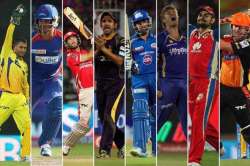IPL 2017: Looking back at the 9 years of match making between entertainment and cricket
Nine years since cricket decided to marry entertainment and name their offspring IPL (Indian Premier League), the Twenty20 mega show has waltzed to the tune of uncharted success, while simultaneously surviving many a slip

Nine years since cricket decided to marry entertainment and name their offspring IPL (Indian Premier League), the Twenty20 mega show has waltzed to the tune of uncharted success, while simultaneously surviving many a slip -- bitter Board of Control for Cricket in India (BCCI) infighting, judiciary-induced changes in the sport's administration -- as also dark episodes that shamed the gentleman's game.
Lalit Modi - Man behind the show
As the cash-rich extravaganza, which catapulted the game to dizzier heights, awaits its 10th edition from April 5, a certain Lalit Modi -- now banned for life by the Indian cricket board for alleged corruption and misuse of power -- cools his heels in London.
It was the same Modi, then an all-powerful man in the BCCI, who, on the back of India's T20 World Cup win in 2007, decided to launch a franchise-based T20 league involving domestic and foreign players.
The event that kickstarted a year later with Modi as the guiding spirit, now has clearly outgrown the "founder". But a more telling commentary is the way the IPL has withstood the often stormy changes in Indian cricket administration.
2008: The year of beginning
In 2008, when the IPL began its journey, the BCCI was helmed by Maratha strongman Sharad Pawar, with the likes of N. Srinivasan keeping things under an iron grip in subsequent years. But now, after the Supreme Court ushered in the far-reaching Lodha reforms, both are ineligible to manage the board. Also gone is the era of heavyweight politicians calling the shots in the BCCI.
The tournament, which saw celebrities like actors Shah Rukh Khan and Juhi Chawla (Kolkata Knight Riders), Preity Zinta (Kings XI Punjab) and business magnate Mukesh Ambani (Mumbai Indians), come forward to own teams, has also emerged as a slayer of icons through the years.
In a nation where cricketing heroes are worshipped like gods, the IPL was conceived around "icon players" shepherding respective franchisees to keep the local flavour intact.
The rise and fall of cricketing Icons
The likes of Sachin Tendulkar (Mumbai Indians), Virender Sehwag (Delhi Daredevils), Rahul Dravid (Royal Challengers Bangalore), Sourav Ganguly (Kolkata Knight Riders) and Yuvraj Singh (Kings XI Punab), enjoyed the special status in the first two seasons, earning 15 per cent more than the highest-earning player from the franchise.
However, the "icons" -- in a rarity for Indian cricket - soon realised they were by no means the bosses. The private owners, having invested big amounts, went strictly by team and individual performances, rather than the fame of a player.
Dravid got sacked as captain in season two, after RCB's failure in the inaugural year, while Ganguly had to leave KKR. More recently, M.S. Dhoni was unceremoniously removed as skipper of Rising Pune Supergiants, with its owner Sanjiv Goenka going to the extent of publicly announcing that the fancied wicketkeeper batsman had not stepped down on his own.
The rise of young talent
But more significantly, through its short history, the IPL has promoted young talent that would otherwise not be rubbing shoulders with international stalwarts and showcasing what they got to the mandarins of the game.
Indian players like Ravichandran Ashwin, Ravindra Jadeja and Suresh Raina, to name a few, were the byproducts of IPL and made the cut for the national team with some additional efforts in other domestic meets.
Around the world, T20 leagues have been aping the IPL with the likes of Australia, the West Indies, South Africa, Bangladesh and Pakistan unveiling their own T20 leagues.
IPL controversies
But the tourney has also had its share of controversies.
Harbhajan Singh slapping S. Sreesanth in the very first season made the headlines.
Sreesanth was in the spotlight for the wrong reasons again in 2013 when he, along with his Rajasthan Royals teammates Ajit Chandila and Ankeet Chavan, was arrested by Delhi Police for match-fixing and connections with bookies.
The BCCI subsequently banned Sreesanth, winner of two World Cups, for life.
The incident also highlighted the involvement of Chennai Super Kings owner and N. Srinivasan's son-in-law Gurunath Meiyappan and Rajasthan Royals owner Raj Kundra. Both the teams have been suspended till 2018 with Gujarat Lions and Sunrisers Hyderabad replacing them.
Also, Kerala franchise Kochi Tuskers managed just one season before their contract was terminated by the BCCI over ownership issues.
Last season, 13 games had to be shifted out of Maharashtra due to drought issues in the state.
Booming business of IPL
But despite all of this, the charm of IPL has refused to take a backseat.
According to global valuation and corporate finance advisor Duff & Phelps, the value of Brand IPL jumped to $4.16 billion after the 2016 edition, against $3.54 billion in 2015.
On the field, it was carnival from the first day with New Zealand's Brendon Mccullum smashing 158 in the opening match for KKR against RCB.
Since then, maverick West Indian Chris Gayle made sure the tourney had its own storm named after him (Gayle storm), Sunil Narine made everyone sit up and take notice of his bowling, A.B. de Villiers played some unimaginable shots and Mathew Hayden invented the mongoose bat (a bat with a longer handle and smaller blade) to better clobber the bowlers.
RCB skipper Virat Kohli has been as consistent as he is playing for India, emerging the highest scorer (4,110 runs), with Lasith Malinga (Mumbai Indians) underlining the importance of bowling yorkers in T20 cricket as the highest wicket taker (143 scalps).